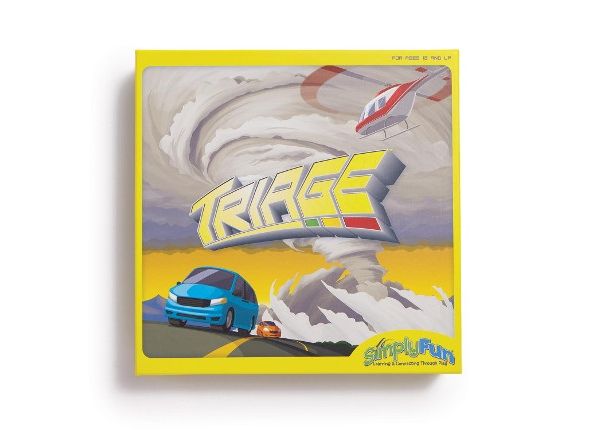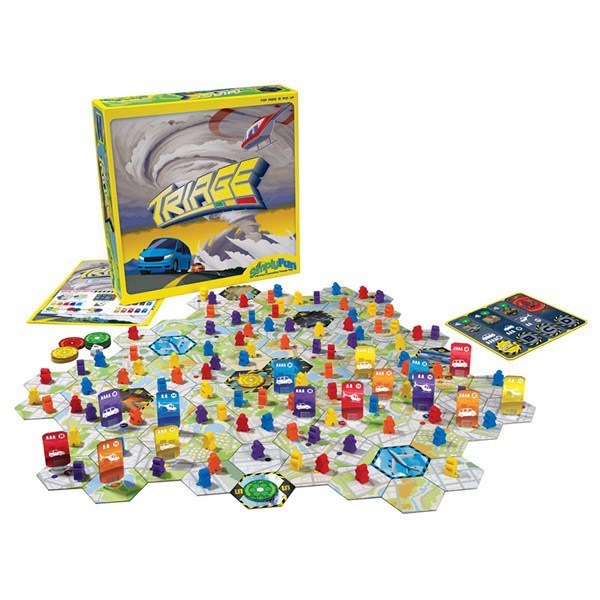Evacuate the City in Pick Up and Deliver Game Triage

Hurricanes! Volcanoes! Tornados! Oh my! Disaster has struck and you must race to the rescue to evacuate your people out of the city.
Published by SimplyFun, Triage is a competitive game about plotting an ideal course through the city, picking up and dropping people off, as threat levels rise and everyone races to the airfields.
Gameplay
The game comes with twelve irregularly shaped tiles, with each tile showing seven spaces. At the start of the game you randomize their set up, so that it’s different each game. Each player then takes the twenty meeples in their player colors and places them on the spaces indicated on the tiles. You also take your car, van, and helicopter pawns and place them at the starting locations also marked on the tiles. Most spaces on the tiles are city spaces, but there are two airfield spaces and seven disaster spaces. Each disaster space is numbered one through seven.
Each round is divided into four phases. At the start of the first two phases, the die is rolled. If it rolls an eight, nothing happens. If it rolls a one through seven, the impact level on the disaster space whose number corresponds to the die roll increased by one. All disaster spaces start the game at impact level zero. If a space ever reaches impact level five, the game immediately ends and everyone calculates their scores. At the start of the third phase, the die is also rolled; only the impact level at the disaster space rolled goes down one.
During the first phase, all players take turns moving their vans. Each van can move up to two spaces and carry up to four meeples. For the second phase, everyone may move their cars, which can carry three people and move three spaces. During the third phase, you move the helicopters, which can move four spaces but only carry two meeples.
While moving through a space, a vehicle can pick up a meeple or drop them off for free. You can only pick up meeples of your own player color. You can move through a space with another vehicle but you cannot stop on a space with another vehicle, except for an airfield space. You cannot move onto disaster spaces. When you land on or pass through an airfield with one of your vehicles, you can drop off any meeples it is carrying and they immediately go into your scoring zone.
During the fourth and final phase of a round, the disasters take effect. The impact level of each disaster determines how wide an area each one affects. For example, a disaster space at level one will only affect meeples on adjacent spaces, while one at level two affects meeples on adjacent spaces and spaces adjacent to those.
When a meeple is hit by a disaster, it gets one point of damage if it is in the farthest ring of spaces affected by that disaster, two points for the next closest ring, and then three or more for anything closer. Damage is cumulative if a meeple is affected by two or more disaster spaces on the same turn. When a meeple receives one point of damage it goes on its side. When it has gotten two points of damage it goes on its back, and anything more it is destroyed and returned to the box.
After the fourth phase, a new round begins. Once all your meeples have been evacuated and/or destroyed, you may then rescue your vehicles by bringing them to an airfield. The game ends once everyone is off the board or a disaster space reaches impact level five. You then count up how many meeples and vehicles you rescued: this is your final score. The player with the highest score wins the game with the number of undamaged meeples you rescued acting as a tiebreaker.

Review
Triage is a fun puzzle game. You’re trying to figure out the best way to move your vehicle pawns based on their carrying capacity, their movement points, and which disaster spaces are at what impact level.
The set up at the beginning ensures lots of variety for the puzzle you are trying to solve, from the placement of the airfields to the different disaster sites, to the speed at which the impact level increases at different locations. There is some luck involved because of this, so how tough the puzzle is going to be will vary.
There’s not a lot of direct player interaction here, outside of the fact that two vehicles cannot end on the same space — although this can come into play occasionally, especially at higher player counts and around disaster zones where the impact level is high.
The game can also be a little fiddly as you’re moving meeples around the board along with the transport tokens, trying not to knock over other meeples or change the damage state of those you’re moving. This can be tricky, especially with more players when there can be up to one hundred meeples on the board.
Triage is about adapting to a constantly changing situation. You might pick up meeples just to drop them off in a safer area and come back for them later as you rush off to pull other ones away from specific disasters. You can also keep an eye on how many meeples an opponent has already lost to see if it’s safe to lose a few of your own. This is a challenging puzzle, that has you doing a lot of mental work — if that’s your type of game, this is quite a solid one.
Pros: Set up and die mechanic ensure lots of variety, solid puzzle at the game’s heart
Cons: Moving around the board is a little fiddly, little direct player interaction
Disclosure: we received a complimentary review copy of this game.






